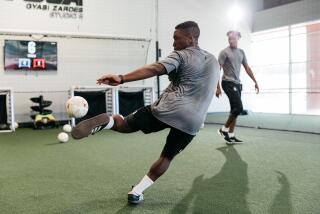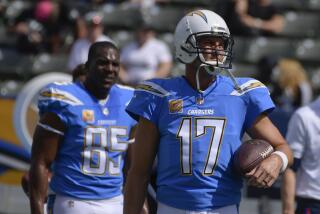HE’S A SPEED DEMON : McNair’s Method to Help Athletes Run Faster Leads to Rapidly Growing Business
- Share via
Kevin McNair is sitting and talking about how successful his training methods have been, about the nearly unbelievable results they’ve produced and about the teams and individuals who are knocking down his Irvine office door in search of his expertise. And the man is being tortured.
The reason for his torment is a four-legged creature that bends McNair’s knees, restricts the sweeps of his arms and impedes his ability to punctuate nearly every statement with a little body English.
A chair has Kevin McNair.
A chair around McNair might as well be a noose. He wiggles, he squirms, he leans forward then presses back, at the slightest opening he bounds to his feet to demonstrate any principle of what has become known as the McNair Method.
What does the McNair Method do? Make just about anyone run faster, that’s all.
McNair has it down to a science, one he developed and has shown and sold across the country.
The Rams, Raiders, Angels, Philadelphia Eagles and San Diego Chargers have used him. So have Stanford, Notre Dame, USC, Iowa and Georgia and a host of Orange County high schools.
The man and his method are hot. Five years ago, he resigned as UC Irvine’s track and field coach to pursue his speed theories, with only one university marking his appointment book.
And now, the list stretches across 17 states, across football fields, tennis courts and baseball diamonds.
It’s enough to slow even a fit man, but McNair’s frantic personality seems to feed on it. It’s a lucky man who finds his niche in the cosmos, and McNair appears to have staked his.
Who better to teach speed than someone whose entire makeup seems to be about violent explosions of movement? When he talks, his face reddens, his eyes bulge as he punches out inflections. As he coaches, he yells encouragement and offers a ready handshake in the same manner one would thrust forth a sword. His steps are quick, heavy and measured.
“When he’s coaching he looks like he’s about to have a stroke,” said Bill Bavasi, Director of Minor League Operations for the Angels.
Make no mistake, Bavasi and the Angels love McNair. So do the Eagles, who once passed the hat so McNair would come back for an early training session.
So does Eagles’ kick and punt returner Henry (Gizmo) Williams, who ran an already scorching 4.39 in the 40 before McNair. After working with McNair, Williams ran a near unbelievable 4.25. The story goes that Gizmo already was aware that he had done something special by the time he crossed the finish line and started jumping and shouting, “Tell the man his (method) works.”
There’s little doubt of that. The last time McNair counted, 505 of 533 athletes who worked with him improved their time in the 40.
“Without a doubt, he’s the best,” said Ronnie Jones, Eagles’ linebacker and strength coach.
McNair’s story begins twice, both times at Stanford University. He was recruited to the school to play football from Bishop Amat High in La Puente. But an illness meant one of his kidneys had to be removed and football was forbidden to him. He did run track at Stanford under two-time Olympic coach Payton Jordan. It was under Jordan that McNair not only wanted to run fast but wanted to know why.
He studied kinesiology and formulated ideas about speed as he coached track and football at Cubberly High in Palo Alto and then Piedmont High. His 1976 Piedmont football team, the last football team he would coach, went 11-0 and won the Northern California championship.
In 1977 he was hired at Occidental College to be the head men’s and women’s track and field and cross-country coach. In his first season, the men’s team won the NCAA Division III championship in both track and cross-country.
By 1979 McNair had moved on to UC Irvine; in 1980 he was named coach of the year in the Pacific Coast Athletic Assn. He helped produce 20 All-Americans at Occidental and UCI.
Though his surroundings changed with regularity, McNair did not. He remained the high school football coach. Exuberant, loud, pacing, yelling, attempting to be everywhere at once.
“His intensity took a little getting used to,” said Larry Knuth, an assistant of McNair’s at UCI and now men’s and women’s track coach at USC.
Danny Williams, head coach of the UCI women’s track team, was a triple jumper when McNair was at Occidental and an assistant under McNair at UCI. He remembers McNair’s voice rustling the leaves a bit during meets.
“If you have a situation where people are real laid back or complacent and then you have a real go-getter like Kevin show up yelling, it’s going to be scary for some people,” Williams said.
McNair said: “I know I can be loud, but if anyone listens to what I say it’s always directed at my team and always very positive. Maybe people just didn’t like the sound of my voice.”
McNair isn’t positive, he is a torrent of praise. “Very good,” is a relative put down for McNair, who throws around perfects as if his students really were.
In 1984, McNair was asked by then Stanford football coach Jack Elway to come up and work with the team. Elway told McNair if he could significantly lower the times of the Stanford players, he would be made a consultant to all Stanford athletics. Sixty-nine of the 74 players dropped their times.
“Jack (Elway) had told the local papers that speed could not be taught,” McNair said. “But after I got those results, he retracted his statement.”
Quicker than McNair can introduce himself, shake your hand and give you a brief history of his career, he had resigned at UCI and started on a new career.
“At the time it was like jumping off a cliff,” he said. “There wasn’t much there. Just Stanford. Luckily the thing has really grown.”
Of course, luck had little to do with it. Results made for fertile business. And results spring forth from the method.
McNair is at once enthusiastic and cautious when it comes to talking about his theories. He’ll tell you one of the main facets of it is something he calls ‘The Hammer,’ a series of body motions that produce a faster human. But break down The Hammer’s parts for a curious observer?
“Let’s just say it works,” he said, smiling.
McNair’s method go against many theories firmly ingrained in the athletic mind. For one, he doesn’t believe that high knees make for faster athletes. His method is the opposite: apply maximum force to the ground.
“I want the athletes to apply force downward and backward on the ground,” he said. “All body parts are implements of that force. If you know how to direct them down and back in a proper way you will have an action that will result in an equal but opposite reaction to where you’re heading.”
Translation: the harder the athlete pushes off the ground, the faster he moves forward. High knees mean nothing, it’s the push. And McNair teaches the athlete how to coordinate the many body movements that go into a proper push, step after step.
Crucial to his instruction is an 18-word vocabulary of terms he shouts to athletes as they run.
“I can be someone’s eyes as they run and make adjustments for them when they need to make adjustments,” he said.
If he says “arch” the athlete knows to arch his back. “Crack,” tells the runner to snap down with his wrists.
“The first few times you hear it, you wonder what language he’s speaking,” said Ryan Darke, the Mission Viejo High fullback, who, along with brother Phil, have worked with McNair for a year. “Then it gets in you so that he’ll just say a word and your body reacts. You don’t even think about it.”
McNair continues to think about speed, constantly refining his process. And as he does, he is constantly finding new ways to spread his knowledge and client base.
For instance, there are some athletes who have worked with McNair who have never actually met him. Through the use of videotapes, McNair critiques the runner, then does voice-overs on the tapes.
There’s also a book planned for this year and perhaps a general instructional video.
He’s built up a nice business, one that he used to run out of a converted bedroom in his home. But these days, McNair goes about his business in an attractive office with a great view of the UCI campus.
“Things are really excellent,” he said.
And they got that way so fast. Of course, for McNair, could there be any other way?
More to Read
Go beyond the scoreboard
Get the latest on L.A.'s teams in the daily Sports Report newsletter.
You may occasionally receive promotional content from the Los Angeles Times.










